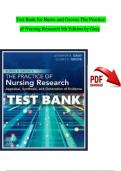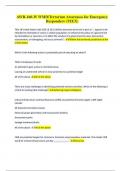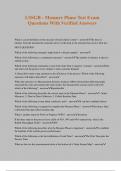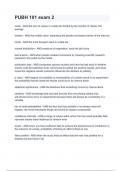Test Bank for Burns and Groves The Practice
of Nursing Research 9th Edition by Gray.
,Chapter 1: Discovering the World of Nursing Research
Test Bank
MULTIPLE CHOICE
1. Nurses with a bachelor’s degree in nursing can participate in the implementation of evidence-
based protocols in practice. This means that the BSN nurse
a. Develops evidence-based guidelines
b. Designs research studies, on which protocols may be based
c. Evaluates and revises evidence-based protocols
d. Contributes practice wisdom when applying protocols in patient settings
e. Mentors PhD researchers in the clinical setting during protocol development
ANS: D
Nurses with a BSN degree have knowledge of the research process and skills in reading and
critically appraising studies. They assist with the implementation of evidence-based
guidelines, protocols, algorithms, and policies in practice. This implies that nurses provide
their point of view, from the clinician’s vantage, when new protocols are being put into
practice, and continue to provide feedback, regarding the positive and negative aspects of
those protocols.
DIF: Cognitive Level: Analysis REF: Page 4
2. Research is designed to test the idea of providing companion dogs to elders in a major
hospital, in order to determine the effect upon the elders’ level of orientation. (The dogs’ level
of orientation will not be a focus of the research.) This type of study can do which of the
following?
a. Control
b. Describe
c. Explain
d. Predict
ANS: A
Control is the ability to manipulate the situation to produce the desired outcome. Description
involves identifying and understanding the nature of nursing phenomena and, sometimes, the
relationships among them. Explanation clarifies the relationships among phenomena and
identifies the reasons why certain events occur. The ability to estimate the probability of a
specific outcome in a given situation in nursing practice is known as prediction. The
researcher’s focus is on predicting what is likely.
DIF: Cognitive Level: Application REF: Page 13
3. A researcher wants to find out whether children with autism who are hospitalized on a
pediatric ward will require more hours of nursing care than average children when the parents
or caregivers are not present. What type of research outcome does this provide?
a. Control
b. Description
c. Explantation
d. Prediction
, ANS: D
Control is the ability to manipulate the situation to produce the desired outcome. Description
involves identifying and understanding the nature of nursing phenomena and, sometimes, the
relationships among them. Explanation clarifies the relationships among phenomena and
identifies the reasons why certain events occur. The ability to estimate the probability of a
specific outcome in a given situation in nursing practice is known as prediction. The
researcher’s focus is on predicting what is likely.
DIF: Cognitive Level: Application REF: Page 16
4. A researcher who desires to determine the cause-and-effect relationship between requiring
that all children under the age of 8 will ride in special care harnesses and the subsequent rate
of children’s spinal cord injury will consequently utilize which form of nursing research?
a. Descriptive research
b. Outcomes research
c. Qualitative research
d. Quantitative research
ANS: D
Quantitative research, the most frequently used method, is a formal, objective, systematic
methodology to describe variables, test relationships, and examine cause-and-effect
interactions. Quantitative research includes experimental research, which is the method for
testing cause-and-effect relationships between and among specific variables. Qualitative
research methods are used for explaining meanings and describing experiences in context.
Descriptive research involves identifying and understanding the nature of phenomena and,
sometimes, the relationships among them. Outcomes research examines the end result of care
in huge populations, most often retrospectively, using a database.
DIF: Cognitive Level: Application REF: Page 3
5. Despite the presence of an intraventricular drain, the intracranial pressure of an ICU neuro
patient remains increased. The nurse recalibrates the machine, makes sure the monitor is on
the same level as the drain, checks all connections, and then notifies the physician, who comes
to the unit and inserts a new drain. What type of reasoning prompts the nurse to recalibrate,
ensure proper placement, and check connections?
a. Abstract reasoning
b. Concrete thinking
c. Logistic reasoning
d. Reality testing
ANS: C
Logistic reasoning is used to break a whole into parts that can be carefully examined.
Concrete thinking is oriented toward and limited by tangible things or by events that are
observed and experienced in reality. Abstract reasoning is oriented toward the development of
an idea without application to, or association with, a particular instance. Reality testing is used
to validate what is observed in the empirical world.
DIF: Cognitive Level: Application REF: Page 6
6. A nurse with considerable clinical expertise develops a policy for managing agitated patients
in the emergency department. The resultant policy emanates from
, a. Abstract reasoning
b. Concrete thinking
c. Logistic reasoning
d. Reality testing
ANS: A
Abstract reasoning is oriented toward the development of an idea without application to, or
association with, a particular instance. Concrete thinking is oriented toward and limited by
tangible things or by events that are observed and experienced in reality. Logistic reasoning is
used to break a whole into parts that can be carefully examined. Reality testing is used to
validate what is observed in the empirical world.
DIF: Cognitive Level: Application REF: Page 7
7. A nurse with considerable clinical expertise develops a policy for managing agitated patients
in the emergency department. The type of reasoning the nurse uses to do this is
reasoning.
a. Problematic
b. Operational
c. Logistic
d. Inductive
ANS: D
Inductive reasoning involves reasoning that moves from the specific to the general, whereby
particular instances are observed and then combined into a larger whole or general statement.
Problematic reasoning involves (1) identifying a problem and factors influencing it, (2)
selecting solutions to the problem, and (3) resolving the problem. Operational reasoning
involves the identification of and discrimination among many alternatives and viewpoints.
Logistic reasoning is used to break the whole into parts that can be carefully examined, as the
relationships among the parts can also be.
DIF: Cognitive Level: Synthesis REF: Page 7
8. What is the best explanation of intuition that forms a legitimate source of knowledge in
nursing?
a. It is based on knowledge thoroughly incorporated into thought but seldom
articulated.
b. It is based on a gift from the universe and should be honored when it arrives.
c. It is never inaccurate.
d. It is a revisiting of old knowledge, accompanied by deep reflection.
ANS: A
Intuition is the revisiting of old knowledge accompanied by deep reflection.
DIF: Cognitive Level: Application REF: Page 5
9. Why is operational reasoning necessary for research?
a. Abstract concepts are of no use to nursing.
b. Standard interventions are obtained from operational reasoning.
c. It allows the researcher to measure the concepts studied.
d. It facilitates the researcher’s rapport with families.
, ANS: C
Operational reasoning involves the identification of and discrimination among many
alternatives and viewpoints. It focuses on the process (debating alternatives) rather than on the
resolution. Nurses use operational reasoning to develop realistic, measurable health goals.
Thus, operational reasoning takes abstract concepts and makes them focused, concrete, and,
therefore, researchable.
DIF: Cognitive Level: Application REF: Page 6
MULTIPLE RESPONSE
1. What are the connections between evidence-based practice and nursing research? (Select all
that apply.)
a. Evidence-based care cannot be provided to patients without the nurse
understanding something of research.
b. A synthesis of current research within an area of nursing is used to improve care in
that area.
c. All patients with a given diagnosis should be cared for based solely on research
knowledge.
d. Nursing diagnosis and management depend on a practitioner’s exploration of best
research evidence.
e. Nursing research provides evidence that allows us each to practice with the same
style and capability.
ANS: A, B, D
Evidence-based practice in nursing requires a strong body of research knowledge that nurses
must synthesize and use to promote quality care for their patients, families, and communities.
In order to synthesize and use research appropriately, a nurse must understand it. A nurse
must explore the best research evidence about a practice problem before using his or her
clinical expertise to diagnose and manage an individual patient’s health problem. Not all
patients are treated in the same way, however. Because reality can vary with perception, and
because the facts can be relative, nurses do not impose their views on patients. Rather, nurses
help patients seek health from within the patients’ worldviews. This is a critical component of
evidence-based practice.
DIF: Cognitive Level: Analysis REF: Page 11
2. What is the hospitalized patient’s place in evidence-based practice? (Select all that apply.)
a. The patient is the recipient of the total of formal research evidence and the nurse’s
practice wisdom, and these represent the patient’s care plan.
b. The patient brings values to the clinical encounter, which the nurse considers in
providing evidence-based care.
c. The patient provides a valuable source of knowledge, since each patient cared for
contributes to the nurse’s total practice wisdom.
d. The patient is the focus of research. The patient serves both as a recipient of
evidence-based research and the subject of future evidence, based on data collected
now from the patient.
e. The patient may always refuse to participate—in evidence-based care, in therapies,
in research participation—and this refusal must be honored.
, ANS: B, C, E
Because reality can vary with perception, and because the facts can be relative, nurses do not
impose their views on patients. Rather, nurses help patients seek health from within the
patients’ worldviews. This is a critical component of evidence-based practice. The nurse’s
individual wisdom is based upon the nurse’s actual practice, over time.
DIF: Cognitive Level: Analysis REF: Page 11
3. In nursing mentorship, as opposed to authority, the novice nurse fills which of the following
roles? (Select all that apply.)
a. Counselor
b. Student
c. Sponsor
d. Disciplinarian
e. Teacher
f. Questioner
g. Apprentice
ANS: B, F, G
An intense form of role-modeling is mentorship. In a mentorship, the expert nurse—or
mentor—serves as a teacher, sponsor, guide, exemplar, and counselor for the novice nurse.
Over time, the relationship morphs into a colleague relationship in which both mentor and
mentee share information and exchange ideas in a cooperative spirit.
DIF: Cognitive Level: Analysis REF: Page 10
4. How are dialectic reasoning and holistic practice similar? (Select all that apply.)
a. They are both based on intuition, not facts.
b. They both consider the whole, rather than one part of the picture.
c. Dialectic reasoning emphasizes truth and holistic practice accepts untruth.
d. They both ignore the main idea or diagnosis and concentrate on different entities.
e. They both honor context and the interactions among ideas and people.
f. They both break down concepts into understandable parts.
g. Dialectic reasoning can be used to validate a study design, whereas holistic
practice does not contribute to research.
ANS: B, E, F
Dialectic reasoning involves looking at situations in a holistic way. A dialectic thinker
believes that the whole is greater than the sum of the parts and that the whole organizes the
parts.
DIF: Cognitive Level: Synthesis REF: Page 6
5. Which of the following statements synopsize the relationship between research and practice?
(Select all that apply.)
a. Practice limits nursing research to issues that are client-centered.
b. Research participation helps nurses to meet re-licensure requirements for evidence-
based practice.
c. Research knowledge, combined with experiential wisdom, constitutes the base for
practice.
, Stuvia.com - The Marketplace to Buy and Sell your Study Material
Material
d. Research emphasizes what can be done in practice, rather than what has been done
in practice.
e. Practice does not affect research: research affects practice.
f. Practice provides inspiration for meaningful nursing research.
g. Practice helps a nurse differentiate between rigorous, well-designed research and
useless research.
ANS: C, F
Evidence-based practice in nursing requires a strong body of research knowledge that nurses
must synthesize and use to promote quality care for their patients. Research is a way to test
reality and generate the best evidence to guide nursing practice. Practice problems inspire
meaningful clinical research. Evidence-based practice evolves from the integration of the best
research evidence with clinical expertise and patient needs and values.
DIF: Cognitive Level: Evaluation REF: Page 3
6. Realistically, what might be done in a situation in which a nurse does not know the
appropriate way to use a new ultrasonic bladder scanner (a non-invasive, painless procedure)
but has an order to scan? (Select all that apply.)
a. Refuse to carry out the order.
b. Ask a co-worker who has used the equipment for help.
c. Access the instructions on the company’s web site.
d. Try to scan the bladder and see if the value obtained makes sense.
e. Notify the manager that a formal inservice is needed.
f. Read the instruction booklet.
ANS: B, C, D, F
Trial and error is an approach with unknown outcomes that is used in a situation of
uncertainty, when other sources of knowledge are unavailable. The profession evolved
through a great deal of trial and error before knowledge of effective practices was codified in
textbooks and journals. The trial-and-error way of acquiring knowledge can be time-
consuming, because multiple interventions might be implemented before one is found to be
effective.
DIF: Cognitive Level: Application REF: Page 9
7. Which of the following sources generates new knowledge for nurses? (Select all that apply.)
a. Editorials in nursing journals
b. Qualitative research
c. Adhering to hospital policies
d. Research that tests a new sling scale for safety of patients and nurses
e. Quantitative research
f. Comparison of two different insulin dosing protocols
ANS: B, D, E
Nursing research is defined as a scientific process that validates and refines existing
knowledge and generates new knowledge that directly and indirectly influences the delivery
of evidence-based nursing. Nurses use a variety of research methods to test their reality and
generate nursing knowledge, including quantitative research, qualitative research, outcomes
research, and intervention research.
, Stuvia.com - The Marketplace to Buy and Sell your Study Material
Material
DIF: Cognitive Level: Application REF: Page 2
8. Which of these are suitable focuses for a nursing research study? (Select all that apply.)
a. How clinical nurse specialists contribute to patient outcomes
b. Which elements of a nursing school curriculum remain useful for current practice
after students graduate
c. Whether requiring nurse managers to supervise more than four units is cost-
effective
d. What styles of physician teaching produce better diabetic compliance
e. Whether patients with exacerbation of CHF are best managed with inpatient
treatment or with outpatient treatment
f. What the personality characteristics are of nurses in various inpatient areas
ANS: A, B, C, F
Many nurses hold the view that nursing research should focus on acquiring knowledge that
can be directly implemented in clinical practice, which is sometimes referred to as applied
research or practical research. However, another view is that nursing research should include
studies of nursing education, nursing administration, health services, and nurses’
characteristics and roles, as well as clinical situations, education, practice, and service.
Research is needed to identify teaching-learning strategies to promote nurses’ management of
practice. Thus, nurse researchers are involved in building a science for nursing education so
that the teaching-learning strategies used are evidence-based. Nurse administrators are
involved in research to enhance nursing leadership and the delivery of quality, cost-effective
patient care.
DIF: Cognitive Level: Application REF: Page 1
9. What might a nursing research study address? (Select all that apply.)
a. Whether having a nurse practitioner manage care is effective in decreasing length-
of-stay
b. Whether students learn better in an online course format or by actual lecture
attendance
c. Comparing four types of leadership used by nurse managers and comparing their
employees’ job satisfaction, absenteeism rates, and error rates
d. Different common surgical procedures and the mortality rate of each
e. Learning specific things about the liver failure patient that can be applied to
nursing practice
ANS: A, B, C, E
Many nurses hold the view that nursing research should focus on acquiring knowledge that
can be directly implemented in clinical practice, which is sometimes referred to as applied
research or practical research. However, another view is that nursing research should include
studies of nursing education, nursing administration, health services, and nurses’
characteristics and roles, as well as clinical situations, education, practice, and service.
Research is needed to identify teaching-learning strategies to promote nurses’ management of
practice. Thus, nurse researchers are involved in building a science for nursing education so
that the teaching-learning strategies used are evidence-based. Nurse administrators are
involved in research to enhance nursing leadership and the delivery of quality, cost-effective
patient care.
DIF: Cognitive Level: Application REF: Page 1
, Stuvia.com - The Marketplace to Buy and Sell your Study Material
Material
Chapter 2: Evolution of Research in Building Evidence-Based Nursing Practice
Test Bank
MULTIPLE CHOICE
1. In which way did Florence Nightingale contribute to evidence-based practice?
a. She conducted research on outcomes and the power of nursing for change.
b. She was the first woman elected to the Royal Statistical Society.
c. She gathered data that changed the care of hospitalized soldiers.
d. She calculated mortality rates under varying conditions.
ANS: C
Nightingale gathered data on soldier morbidity and mortality rates and the factors influencing
them and presented her results in tables and pie charts, a sophisticated type of data
presentation for the period. Nightingale’s research enabled her to instigate attitudinal,
organizational, and social changes. She changed the attitudes of the military and society
toward the care of the sick. The military began to view the sick as having the right to adequate
food, suitable quarters, and appropriate medical treatment, which greatly reduced the mortality
rate.
DIF: Cognitive Level: Application REF: Page 17
2. If a nurse manager wants to study how well last year’s policies governing implementation of a
“bundle” of interventions to prevent cross-contamination of MRSA have been working in her
units, which of the following strategies would she use?
a. Outcomes research
b. Intervention research
c. Ethnographic research
d. Experimental research
ANS: A
Outcomes research emerged as an important methodology for documenting the effectiveness
of health care services in the 1980s and 1990s. This type of research evolved from the quality
assessment and quality assurance functions that originated with the professional standards
review organizations (PSROs) in 1972. During the 1980s, William Roper, the director of the
Health Care Finance Administration (HCFA), promoted outcomes research for determining
the quality and cost-effectiveness of patient care. Intervention research investigates the
effectiveness of a nursing intervention in achieving the desired outcome or outcomes in a
natural setting. Through the use of ethnographic research, different cultures are described,
compared, and contrasted to add to our understanding of the impact of culture on human
behavior and health. Experimental studies have three main characteristics: (1) a controlled
manipulation of at least one treatment variable (independent variable), (2) administration of
the treatment to some of the subjects in the study (experimental group) and not to others
(control group), and (3) random selection of subjects or random assignment of subjects to
groups, or both. Experimental studies usually are conducted in highly controlled settings, such
as laboratories or research units in clinical agencies.
DIF: Cognitive Level: Analysis REF: Page 22
, Stuvia.com - The Marketplace to Buy and Sell your Study Material
Material
3. A researcher publishes a paper describing how faith, pain, adherence to therapy, and
meditation interact during the rehabilitation process. The description of the process is based
on many interviews the researcher conducted with persons during and following rehabilitation
experiences. The methodology is
a. Ethnography
b. Phenomenology
c. Historical research
d. Grounded theory
ANS: D
Grounded theory methodology emphasizes observation and the development of practice-based
intuitive relationships among variables. Throughout the study, the researcher formulates, tests,
and redevelops propositions until a theory evolves. The theory developed is “grounded,” or
has its roots in, the data from which it was derived.
DIF: Cognitive Level: Synthesis REF: Page 27
4. A panel of researchers conducts several studies, all drawn from an existent hospital and clinic
database. The studies focus on quality and effectiveness within that system. The specific
studies address mortality rates in elders within a year after hip fracture, functional outcomes
six months after admission to a neurosurgical ICU after traumatic brain injury, rate of nurse
injuries in an emergency department, and number of patient falls on various floors of the
hospital. What type of research is this?
a. Experimental research
b. Outcomes research
c. Ethnographic research
d. Grounded theory research
ANS: B
The spiraling cost of health care has generated many questions about the quality and
effectiveness of health care services and the patient outcomes. Consumers want to know what
services they are buying, and whether these services will improve their health. Health care
policy makers want to know whether the care is cost-effective and of high quality. These
concerns have promoted the development of outcomes research, which examines the results of
care and measures the changes in health status of patients. It can also examine costs related to
care delivery within a hospital system.
DIF: Cognitive Level: Comprehension REF: Page 27
5. A researcher designs a study. It depends on questionnaires for data, it has a clear purpose
statement, it provides its results as a narrative without statistical analysis, and it makes general
suggestions for practice. What type of research is this?
a. Qualitative research
b. Outcomes research
c. Intervention research
d. Quantitative research
ANS: D







